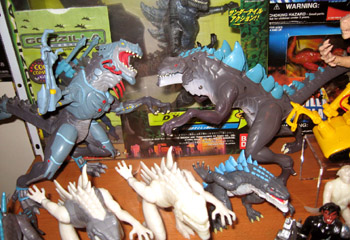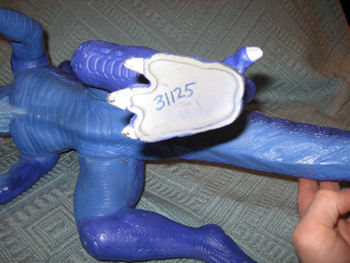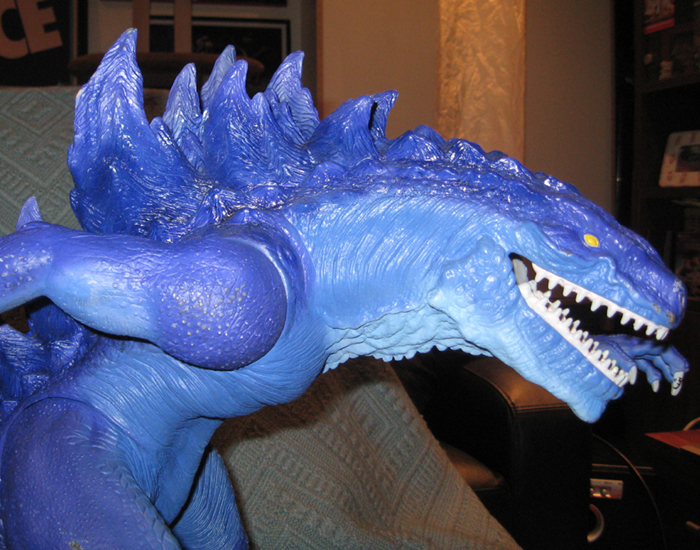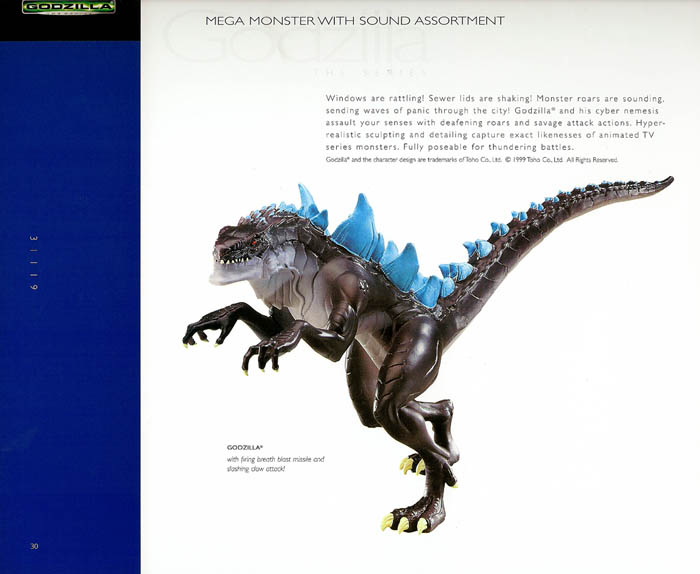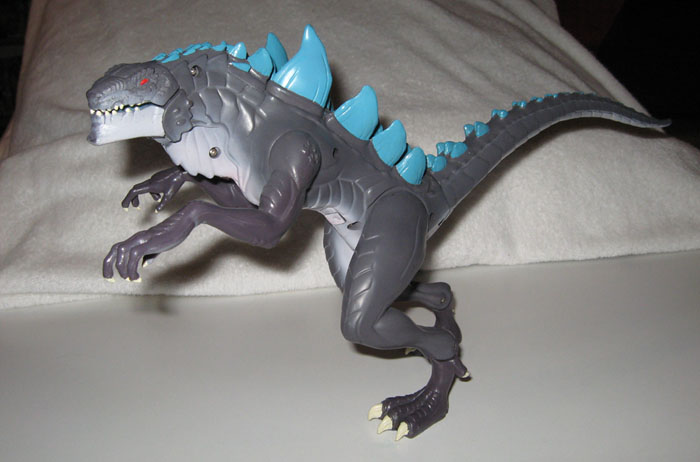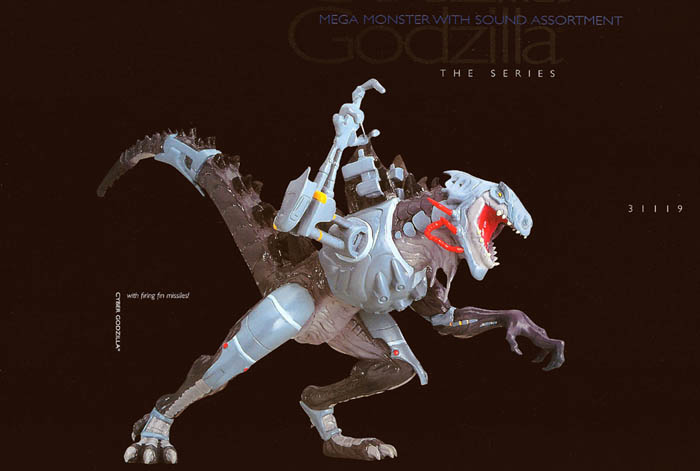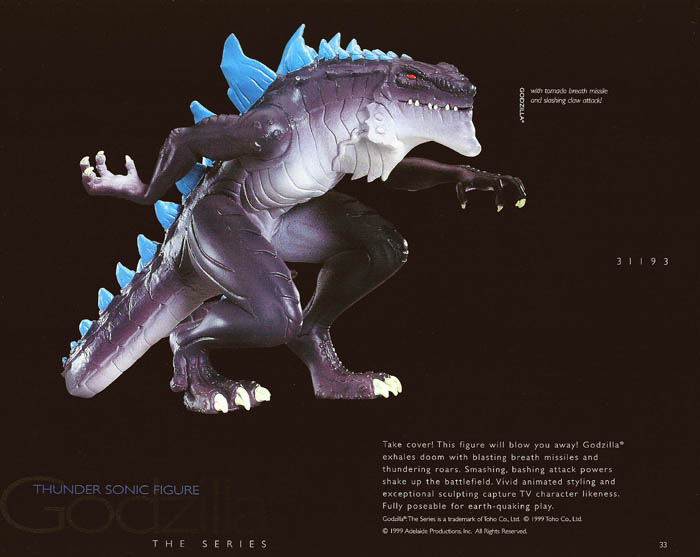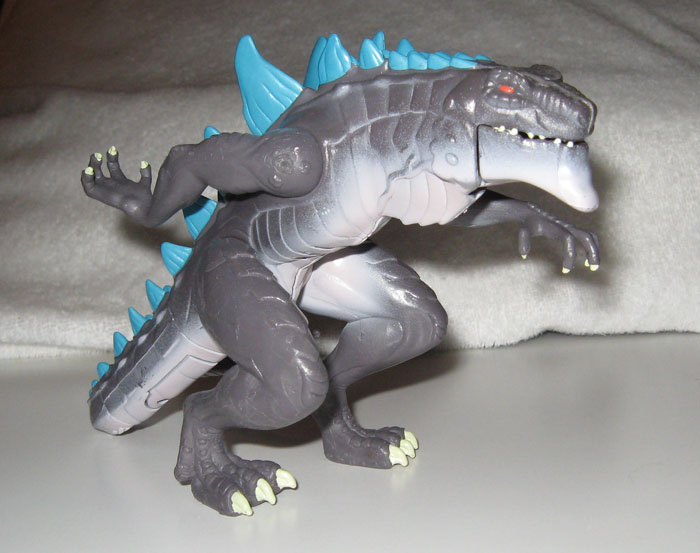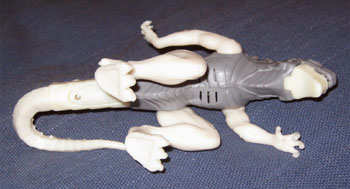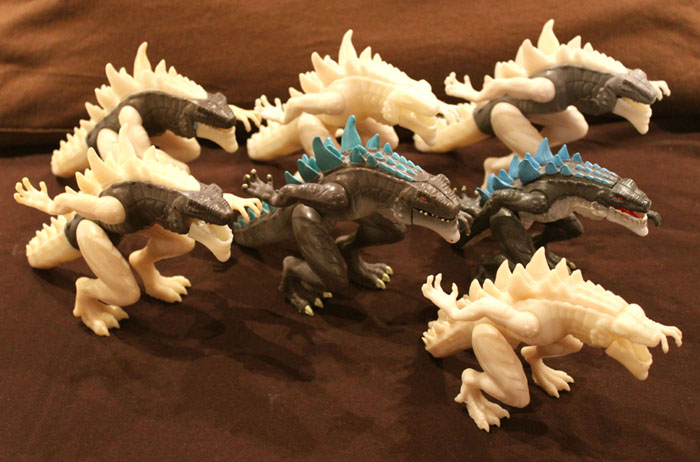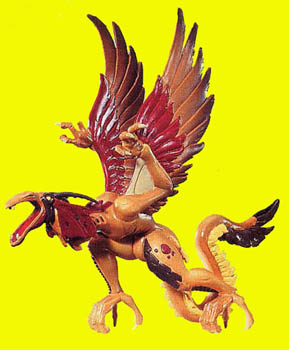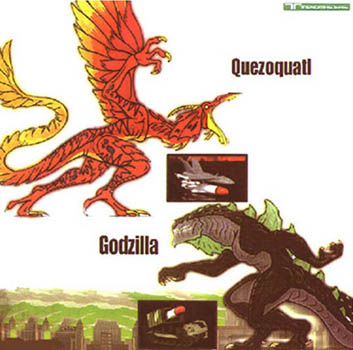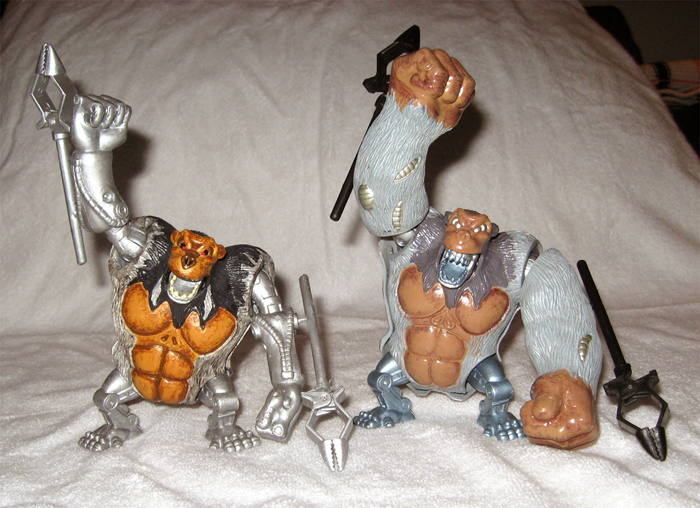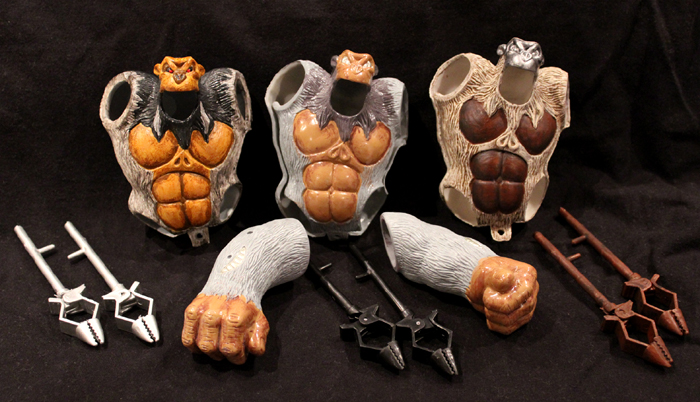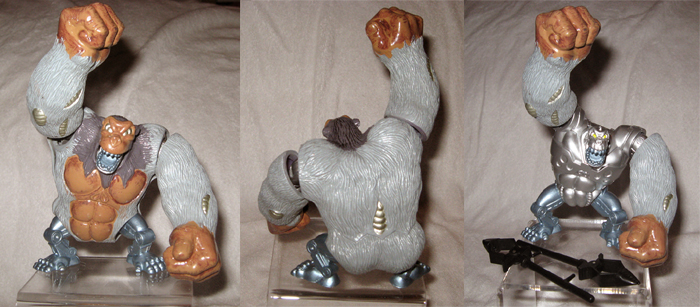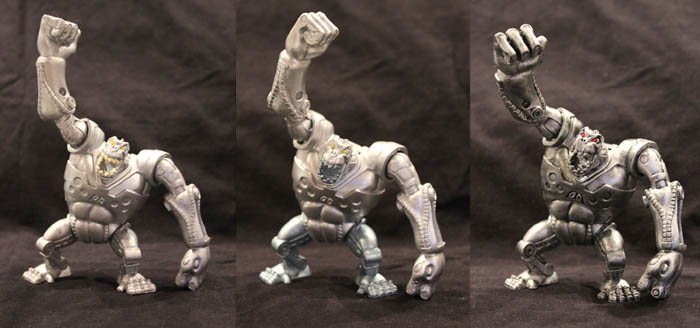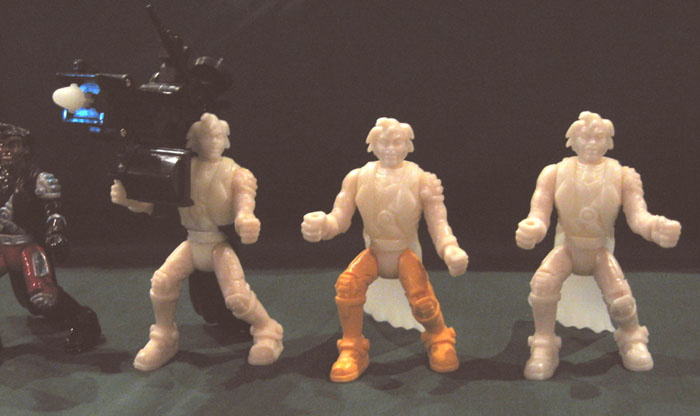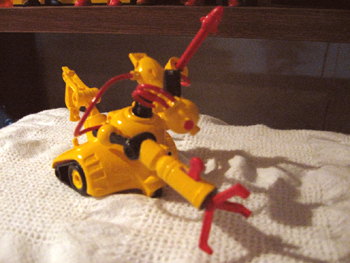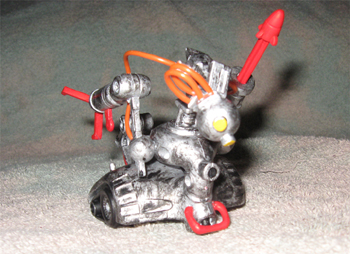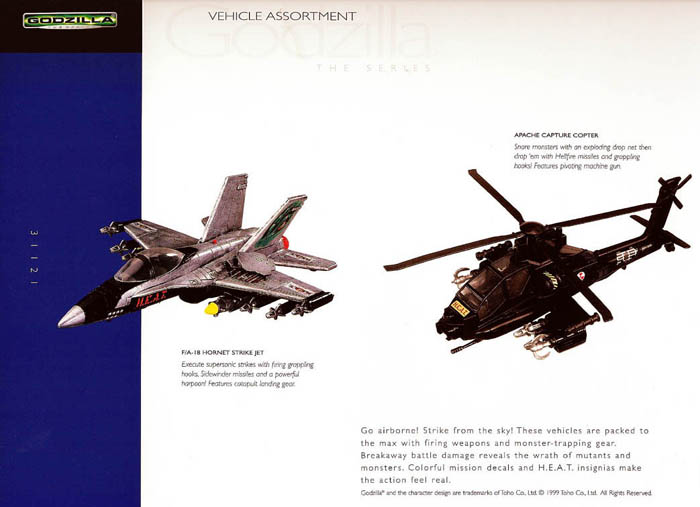 Logo for GODZILLA: THE SERIES. Photo courtesy of Sony Pictures Family Entertainment. © 1998 Toho Co., Ltd./Adelaide Productions, Inc.
Logo for GODZILLA: THE SERIES. Photo courtesy of Sony Pictures Family Entertainment. © 1998 Toho Co., Ltd./Adelaide Productions, Inc.Author: Jonathan Shyman and Keith Aiken Special Thanks to Andrew Wong, Bill Bronson and Brian Weinstock Article updated with additional photos, May 2012.
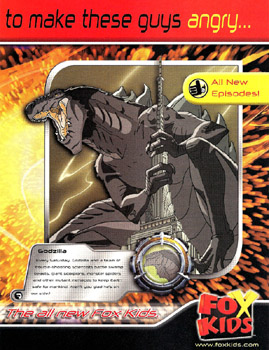 Fox Kids advertisement for GODZILLA: THE SERIES. Photo courtesy of Jonathan Shyman. © 1998 Toho Co., Ltd.
Fox Kids advertisement for GODZILLA: THE SERIES. Photo courtesy of Jonathan Shyman. © 1998 Toho Co., Ltd.Editor`s Note: Back in 1998, I was a storyboard artist working for Sony Pictures Family Entertainment on GODZILLA: THE SERIES, the Saturday morning animated show spun-off from the studio`s big budget GODZILLA movie released worldwide that May. During my time on the show I saw photos and illustrations for a variety of proposed G:TS merchandise ranging from T-shirts to lunchboxes to video games. As both a lifelong Godzilla fan and a part of the creative team for the show I was intrigued by all the different products being considered for release, but what most caught my eye were images of GODZILLA: THE SERIES action figures developed by Trendmasters, the St Louis, MO-based company that had already produced extensive toy lines based on both the original Toho Godzilla characters and the American film. Unfortunately, the G:TS toy line was not to be. Sony`s GODZILLA film had been heavily promoted and was widely expected to be the box office hit of 1998. Companies jumped on the bandwagon, licensing the movie for toys, books, food items, clothing, advertising campaigns, and so on. The products initially sold very well... and then GODZILLA hit cinemas and was roundly trashed by film critics, general audiences, hardcore Godzilla fans, and owners of the major theater chains exhibiting the picture. By the time GODZILLA: THE SERIES premiered on Fox Television`s Saturday morning "Fox Kids" block that September retailers across the nation found themselves stuck with shelves of GODZILLA merchandise that wasn`t selling. Despite the cartoon show`s ratings success— it was the Number 1 program among boys 6-11 on any broadcast network— and the generally positive response from Godzilla fans, retailers were simply not interested in purchasing more Godzilla products at that time. Advance orders for the first wave of G:TS toys were so low that Trendmasters canceled the line before it went into production.
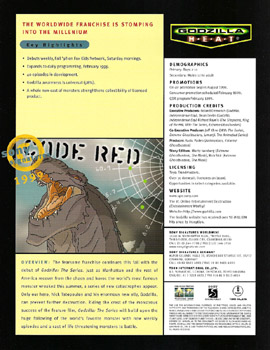 Trendmasters toy license was mentioned in this Sony Pictures ad slick for the show. Photo courtesy of Jonathan Shyman. © 1998 Toho Co., Ltd.
Trendmasters toy license was mentioned in this Sony Pictures ad slick for the show. Photo courtesy of Jonathan Shyman. © 1998 Toho Co., Ltd.But during the development of the GODZILLA: THE SERIES line, Trendmasters had produced promotional artwork, character designs, and also resin and plastic prototypes for several of the characters. Only a handful of prototypes were created for each figure, making them exceptionally rare items. But eventually these materials made their way to the collectors` market, and much of what became available over the years was purchased by Jonathan Shyman, an animator and collector of Trendmasters toys and prototypes. A few months ago Jonathan posted photos of some of his G:TS prototype figures on the Godzilla fan site G-Forever run by Andrew Wong. Andrew put me in touch with Jonathan, who kindly offered to share photos and write descriptions of his GODZILLA: THE SERIES prototypes, and provide scans of catalog and promotional materials. Jonathan wrote, "I began my collection of Trendmasters prototypes and their unreleased toys back in 2002-2003, shortly after they closed their doors. There was quite a flood of their toys on eBay then, and some went for big money, and others went for just peanuts. Prototypes in general are an interesting thing, considering they were never meant to be sold to the public, and were often much better figures then the actual released toys. Prototypes usually had better and different molds, and definitely better paint jobs for up close viewing at toy shows like Toy Fair. And a lot of figures that make it to Toy Fair don`t necessarily make it into final production, so pretty much any prototype can be considered rare. And if Trendmasters never closed, there`s a good chance most of these toy figures would never have been accessible, so I know I am very fortunate to have what I have." Regarding the GODZILLA: THE SERIES toys, he added: "After being greatly disappointed in the 1998 film version of GODZILLA, my interest turned to the animated version. So, while trying to discover what toys Trendmasters produced, I caught a photo of the Cyber-Godzilla prototype figure and was completely amazed. I thought it was a wicked figure, with a totally dynamic pose, and captured the cartoon likeness perfectly. Well, to my surprise, one of the prototypes appeared on eBay that week, and I was lucky enough to grab it. To this day, I still think it`s one of the coolest unproduced toy figures I have ever seen, and one of my all time favorites." I also spoke with Bill Bronson and Brian Weinstock, who had worked on the toy G:TS line and were willing to supply details about Trendmasters and the animated Godzilla figures. The following article contains information and images from Jonathan, Bill, and Brian plus character design art from Sony Pictures so readers can compare the toys with the animated characters they were based upon. Jonathan Shyman is still actively collecting Trendmasters prototypes and sales materials. Anyone who would like to discuss the Trendmasters toy lines or has items to sell can contact Jonathan at This email address is being protected from spambots. You need JavaScript enabled to view it..
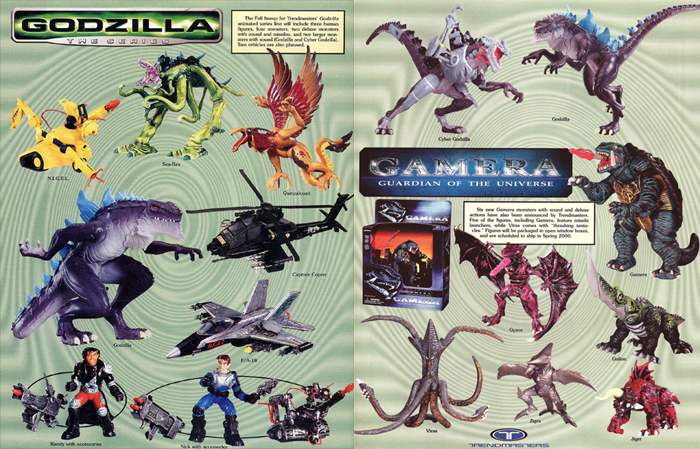 Double page spread from Action Figure Digest showing Trendmasters` GODZILLA: THE SERIES toy line (as well as figures in the company`s GAMERA: GUARDIAN OF THE UNIVERSE collection). Photo courtesy of Jonathan Shyman. Godzilla © 1998 Toho Co., Ltd.
Double page spread from Action Figure Digest showing Trendmasters` GODZILLA: THE SERIES toy line (as well as figures in the company`s GAMERA: GUARDIAN OF THE UNIVERSE collection). Photo courtesy of Jonathan Shyman. Godzilla © 1998 Toho Co., Ltd.Trendmasters
Trendmasters Inc was founded in 1989 by Leo Hauser and Russell Hornsby, a former toy designer for Mattel. The company had early success with the burping, screaming LOONY HEADS line for boys and the STAR CASTLE line for girls. Looking for a position in a marketplace dominated by Mattel and Hasbro, Trendmasters focused on licensing what Hornsby called "the abused properties of Hollywood"; characters and properties with name-recognition value that had nevertheless been passed over by the toy industry giants. "Our job is to take them and dress them up and give them a beautiful face again," Hornsby told the Associated Press in 1998.
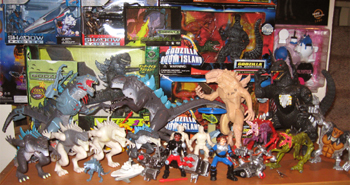 Jonathan Shyman`s GODZILLA: THE SERIES collection. Photo courtesy of Jonathan Shyman. © 1998 Toho Co., Ltd.
Jonathan Shyman`s GODZILLA: THE SERIES collection. Photo courtesy of Jonathan Shyman. © 1998 Toho Co., Ltd.Trendmasters struck gold when they licensed the Godzilla franchise from Toho Co., Ltd. in 1994. In the early 1990s Godzilla had largely fallen out of the public eye in the United States, but in Japan the character was experiencing a resurgence in popularity thanks to a new series of films and a massive merchandising blitz. Trendmasters latched onto the franchise at the right time; appealing to hardcore Godzilla fans in North America who were aware of what was happening in Japan, and also catching the general groundswell of interest in the character building up to Sony`s Hollywood GODZILLA remake, still almost four years away. The company launched their GODZILLA: KING OF THE MONSTERS line with action figures and playsets featuring Toho`s "Big Five" monster stars Godzilla, Rodan, Mothra, King Ghidorah and Mechagodzilla. A second series, entitled GODZILLA WARS, would include characters such as Spacegodzilla and Mogera from the newer Japanese films. Plans for a third wave called GODZILLA DOOM ISLAND were drastically cut back, and only a limited number of pieces were sold through the Trendmasters website. But, between the three series, the company would produce the largest Godzilla product line ever released in America with action figures, wind-up toys, micro-playsets, large electronic figures, multi-figure packs, bendies, large scale playsets, and a 40th anniversary collector`s set of figures.
With the success of their Godzilla series, Trendmasters would go on to produce numerous toy and collectibles lines based on new and well-known characters and movies. Some of the properties Trendmasters released include Tarzan, MARS ATTACKS!, INDEPENDENCE DAY, LOST IN SPACE (both the classic TV show and the 1998 film), Casper the Friendly Ghost, THE IRON GIANT, Gamera, EXTREME GHOSTBUSTERS, DEXTER`S LABORATORY, VOLTRON: THE THIRD DIMENSION, the Coca-Cola bears, BATTLEFIELD EARTH, Gumby, TALES FROM THE CRYPT, JUMANJI, Austin Powers, BATTLESTAR GALACTICA and POWERPUFF GIRLS. They also produced their own original creations such as the interactive C-Watches and the hugely successful RUMBLE ROBOTS toys. At its peak, Trendmasters was the third ranked US toy company behind the old guard of Mattel and Hasbro. Trendmasters also went international, signing a distribution deal in the UK with the British company Bluebird Toys PLC. But Trendmasters took a risk on many of the properties they had licensed, and that gamble failed to pay off too many times. The box office failures of films like MARS ATTACKS! and BATTLEFIELD EARTH had killed any demand for merchandising, including toys. Trendmasters had also developed a large product line for OSMOSIS JONES, an animated film from 2001 that was ignored by audiences more interested in the works of Disney or Dreamworks. Despite heavy promotion at industry events such as Toy Fair, the OSMOSIS JONES toys were never made. Many of the pieces developed for that line are now owned by Jonathan, who may have the largest collection of OSMOSIS JONES collectibles in the world. By early 2002, Trendmasters was on its last legs. Russell Hornsby left that summer and launched a new company, Cepia LLC, which had a major success with Zhu Zhu Pets, one of the top selling toy lines of 2009. Trendmasters shut down in the Fall of 2002 and its assets were sold to to the California-based toy company JAKKS Pacific Inc in December of that year.
GODZILLA: THE SERIES
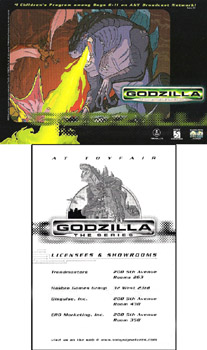 Front and back of a GODZILLA: THE SERIES card distributed by Sony at Toy Fair. Photo courtesy of Jonathan Shyman. © 1998 Toho Co., Ltd.
Front and back of a GODZILLA: THE SERIES card distributed by Sony at Toy Fair. Photo courtesy of Jonathan Shyman. © 1998 Toho Co., Ltd.Sony Signatures, the entertainment merchandising division of Sony, handled the merchandising rights for the 1998 GODZILLA movie. Trendmasters already held the toy license for the original Godzilla so they were a natural choice to do the same for the new film. The agreement between Sony Signatures and Trendmasters gave the latter company the rights to produce action figures and vehicles from both the American GODZILLA movie and the GODZILLA: THE SERIES Saturday morning cartoon show. Supervising creative development for GODZILLA `98 and GODZILLA: THE SERIES was Brian Weinstock, VP of Brand Management for Trendmasters who had joined the company in 1991. "I was with Trendmasters for 11 years," Brian told SciFi Japan. "I directed creative development on the action figure ranges (Tarzan, MARS ATTACKS!, ID4, LOST IN SPACE, Godzilla), boys toys (STORM GUNS, etc), licensed items (POWERPUFF GIRLS) and RUMBLE ROBOTS." After the closure of Trendmasters in 2002, Weinstock started Really Big Ideas LLC, a product development and consulting group specializing in toys and games. Joe McGowan was in charge of product designs for Trendmasters. Working under McGowan was a stable of artists that included Bill Bronson, Lorenzo Lizana, Paul Brown, and Butch Burcham. The art team already had experience with Godzilla, having designed the toys for the company`s Toho Godzilla toy range. Burcham, who had been the main Godzilla artist early on, left Trendmasters for his own projects so Bronson and Lizana handled the majority of the GODZILLA: THE SERIES line. The artists would design poses for Godzilla and the other characters and then sketch those poses from four or five different angles to use as guides for the sculptors.
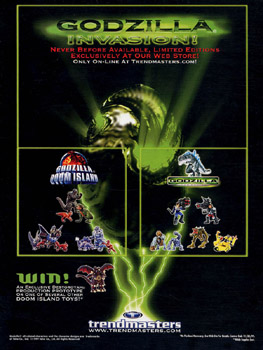 Trendmasters briefly considered releasing the G:TS toys as online exclusives. Photo courtesy of Jonathan Shyman. © 1998 Toho Co., Ltd.
Trendmasters briefly considered releasing the G:TS toys as online exclusives. Photo courtesy of Jonathan Shyman. © 1998 Toho Co., Ltd.According to Brian Weinstock, the first characters chosen for the toy line were "Godzilla and those kids who chased him around. We went for the main characters... whoever would be the most popular based on the show." Bill Bronson added that he also came up with some original monster concepts in the hopes that Sony Pictures Family Entertainment would select them to appear on GODZILLA: THE SERIES, but the producers for G:TS already had an in-house character and creature design team to do that job. Bronson instead turned his attention back to adapting Sony`s G:TS character designs as three dimensional figures. From the concept sketches, a prototype figure was sculpted in resin. After feedback from supervisors and Sony Signatures, minor modifications would be made. Variant paint jobs were also tested for some figures. Once the sculpt was approved, a handful of pieces— generally less than a dozen— were molded in plastic and "playability features" were added. These features would include options such as jointed limbs that could be posed, jaws that open and close, spring-loaded limbs and firing weapons, sound chips, etc. The Trendmasters GODZILLA: THE SERIES toy line was scheduled to debut in the Fall of 1999, coinciding with the series` second season premiere. But when initial retail orders for the toys proved too low for a wide release, the company canceled the launch and considered other options. At one point Trendmasters planned on producing limited numbers of the figures and selling them online exclusively through the company`s website. But they soon abandoned those plans, and the GODZILLA: THE SERIES line never saw the light of day.
 Closing shot from unaired Trendmasters GODZILLA: THE SERIES television commercial. Photo courtesy of Jonathan Shyman. © 1998 Toho Co., Ltd.
Closing shot from unaired Trendmasters GODZILLA: THE SERIES television commercial. Photo courtesy of Jonathan Shyman. © 1998 Toho Co., Ltd.GODZILLA: THE SERIES Ultimate Godzilla
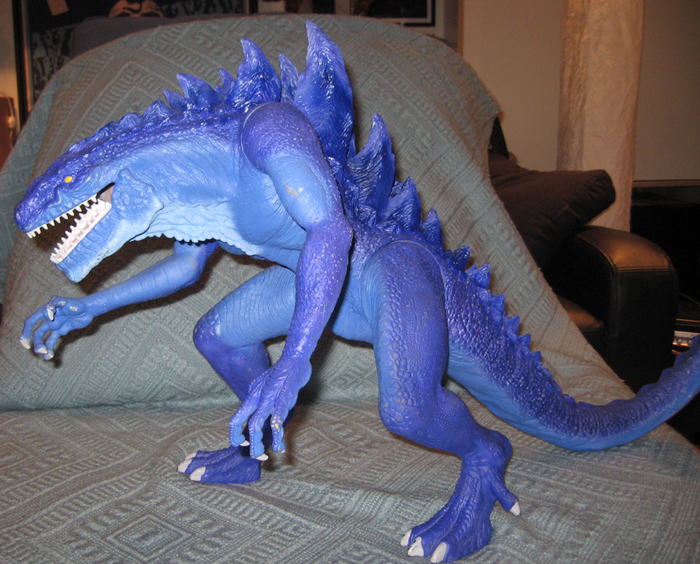 The GODZILLA: THE SERIES Ultimate Godzilla prototype. Photo by Jonathan Shyman. © 1998 Toho Co., Ltd.
The GODZILLA: THE SERIES Ultimate Godzilla prototype. Photo by Jonathan Shyman. © 1998 Toho Co., Ltd.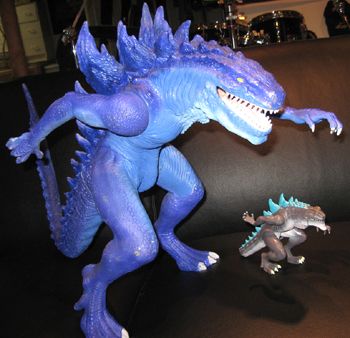 Size comparison between Ultimate Godzilla and Thunder Sonic Godzilla figures. Photo by Jonathan Shyman. © 1998 Toho Co., Ltd.
Size comparison between Ultimate Godzilla and Thunder Sonic Godzilla figures. Photo by Jonathan Shyman. © 1998 Toho Co., Ltd.One of the first toys planned for the GODZILLA: THE SERIES line was actually a revamp of an existing GODZILLA (1998) figure. Designed by Bill Bronson, the Ultimate Godzilla was a massive figure standing over a foot tall and more than two feet in length. It came with movable limbs and tail, a push button Godzilla roar, and a mouth large enough to swallow the human action figures released in the same series. Generally considered the best G`98 figure by collectors, the Ultimate Godzilla also holds a unique place in the history of Toho`s Godzilla films. Toho used the toy like a maquette, scanning it for the computer generated model of the monster `Zilla` that appeared in the 50th anniversary Godzilla movie, GODZILLA: FINAL WARS (Gojira Fainaru Uozu, 2004). Trendmasters began work on their GODZILLA: THE SERIES range while the animated show was still in the early stages of development at Sony Pictures Family Entertainment, well before the final approved look for the cartoon version of Godzilla had been decided. Jonathan Shyman reported that, "This figure is funky and quite unusual to say the least... This was in the very early stages of planning for the Animated Series line. Since the aluminum mold from the GODZILLA movie line was already paid for, an "Ultimate/Animated Godzilla" hybrid figure was proposed and painted in the Animated Series style with bright blue and purple colors." This allowed Trendmasters to get an early start on the G:TS line, and also further recoup some of the money they had invested in developing the Ultimate Godzilla in the first place.
A much smaller number of prototypes than usual were produced of this GODZILLA: THE SERIES Ultimate Godzilla. Only two of the figures are known to exist... one now owned by Jonathan, the other in the hands of another private collector. Jonathan`s figure is marked "31125" under the left foot, which corresponds with the Item Number given for the G:TS Ultimate Godzilla in the Trendmasters Product Review Guide issued to retailers for 1998-1999.
Mega Monster with Sound Assortment
Among the nicest-looking G:TS action figures Trendmasters had in the works were the "Mega Monster with Sound" line. Launching with Godzilla and his opponent Cyber-Godzilla, these large (standing approximately 9" to 10" tall) poseable figures came with push button monster roar sound features. The sound features could also be switched to "sentinel mode", in which the monster`s roar would be activated by a CDS (cadmium sulfide) photocell motion sensor. The Mega Monster with Sound toys would have been packaged in an open window box and included a plug-on display base to allow the figure to stand without tipping over. GODZILLA
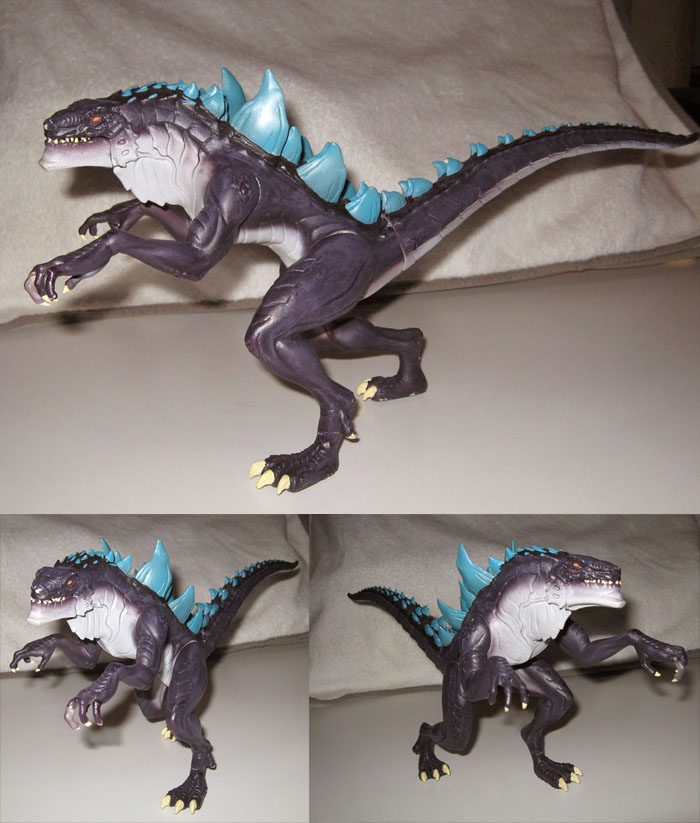 Three views of the resin Godzilla prototype figure. Photos by Jonathan Shyman. © 1998 Toho Co., Ltd.
Three views of the resin Godzilla prototype figure. Photos by Jonathan Shyman. © 1998 Toho Co., Ltd.The Mega Monster with Sound Godzilla stood approximately 10" tall and, unlike the GODZILLA: THE SERIES Ultimate Godzilla, was an accurate depiction of the animated Godzilla. Play features included the classic Godzilla roar, a "Firing Breath Blast Missile" (a projectile that would shoot out of Godzilla`s mouth, simulating the monster`s radioactive ray), and the "Slashing Claw Attack" (a spring loaded arm swing). Some promotional materials also mentioned "passive light" dorsal fins, which would have been molded in a translucent plastic to replicate Godzilla`s trademark glowing fins.
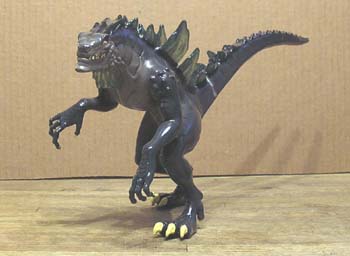 Another Godzilla resin figure, featuring a different paint job than the other prototypes. Photo courtesy of Jonathan Shyman. © 1998 Toho Co., Ltd.
Another Godzilla resin figure, featuring a different paint job than the other prototypes. Photo courtesy of Jonathan Shyman. © 1998 Toho Co., Ltd.Trendmasters created several prototypes of the Mega Monster with Sound Godzilla, in both resin and plastic. Jonathan explained, "I do believe, in this particular case, the plastic figure is actually more rare. I can`t confirm if 12 plastic prototypes were produced, but I`m pretty sure 12 resin protos were." "This plastic figure was indeed the first `fully functional` 10" figure of this piece that I have seen. When I say fully functional, I mean there is sound with this figure, the Godzilla roar rings out nice and loud when you move the large blue fin on the figure`s left side, and the mouth opens as you do that. It also shoots a missile out of it`s mouth at the same time. Very cool. However, as you can see in the comparison shots, the plastic figure shows all the screws in the joints when photographed on it`s left side. Of course you can`t hide those, but on the resin one, it`s quite different." "I actually prefer the resin piece over the plastic figure. The resin piece actually stands on it`s own, where the plastic one`s weight seems to be unevenly placed [which would have been less of an issue if the figure had been mass produced with the snap-on base]. In the photos, I am using mack tack to keep the feet in place on the plastic figure, and as I was taking the photos it was literally falling over. The resin figure also has the opening jaws, triggered with the large left sided fin, but there`s no sound mechanism on this piece. The resin sculpt just has a more raw, meaner look to it, with an exact TV likeness, and is one of my favorites from this line." "Trendmasters often did many different color options on their figures, and I have included one variant of this Godzilla figure to show the differences in how it turned out. This "repaint" figure came with almost jade-colored translucent fins and yellow eyes. I actually like it more and more after comparing it to my properly colored resin figure."
 Two comparisons of the resin (left) and plastic (right) figures. Photos by Jonathan Shyman. © 1998 Toho Co., Ltd.
Two comparisons of the resin (left) and plastic (right) figures. Photos by Jonathan Shyman. © 1998 Toho Co., Ltd. Animation model sheets for Godzilla. Photo courtesy of Sony Pictures Family Entertainment. © 1998 Toho Co., Ltd./Adelaide Productions, Inc.
Animation model sheets for Godzilla. Photo courtesy of Sony Pictures Family Entertainment. © 1998 Toho Co., Ltd./Adelaide Productions, Inc.CYBER-GODZILLA
 Three angles of the plastic Cyber-Godzilla prototype figure. Photos by Jonathan Shyman. © 1998 Toho Co., Ltd.
Three angles of the plastic Cyber-Godzilla prototype figure. Photos by Jonathan Shyman. © 1998 Toho Co., Ltd.The other figure initially planned for the Mega Monster with Sound lineup was Cyber-Godzilla. Introduced in GODZILLA: THE SERIES Episode 116- MONSTER WAR- Part 2, the character was the animated show`s take on the popular Godzilla foe Mechagodzilla, the robotic monster that first appeared in Toho`s movie GODZILLA VS MECHAGODZILLA (Gojira tai Mekagojira, 1974). In the series, Cyber-Godzilla is the reanimated corpse of the 1998 movie Godzilla, brought back to life as a cyborg by aliens as part of their plans to conquer Earth. As the parent of the Godzilla from the animated series, Cyber-Godzilla set up a classic "father vs son" dynamic with his offspring which resulted in the cyborg being torn to pieces by the new Godzilla.
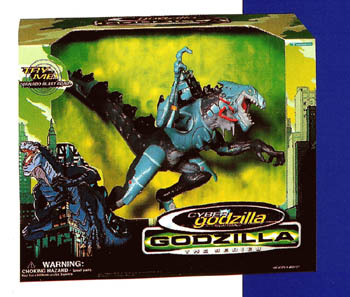 Promotional photo showing the planned packaging for the Cyber-Godzilla figure. © 1998 Toho Co., Ltd.
Promotional photo showing the planned packaging for the Cyber-Godzilla figure. © 1998 Toho Co., Ltd.Like the Mega Monster with Sound Godzilla, the Cyber-Godzilla figure stood approximately 10" tall. The toy was poseable and came with the "Tornado Blast Roar" (sound of the monster`s roar) and two firing fin missiles. Jonathan Shyman wrote, "Without a doubt, this is indeed my favorite of the entire series line, and one look at the pose should be a dead giveaway as to why. The pose is so dynamic for an action figure, it blows me away whenever I look at it! My figure is plastic, and the catalog picture is resin. My plastic version does have a sound activation button close to the groin, and also shoots the two missiles from the fins. That feature doesn`t work the best, but actually works more like a spring motion... if you press on the missiles all the way in, they shoot back out. Nothing fancy." As was usually the case, the original resin prototype was more detailed than the later plastic version. This was particularly true for Cyber-Godzilla; the resin sculpt more accurately copied the look of features such as the monster`s neck which were simplified in the plastic prototype figure. "From what I heard again," Jonathan explained, "there was at least twelve of these made up, and all were slightly different to some degree... mainly color-wise, since Trendmasters was usually unsure of the final colors until close to when they were due to go into production. They definitely nailed it with the robotic arm. Just a really beautiful figure all around."
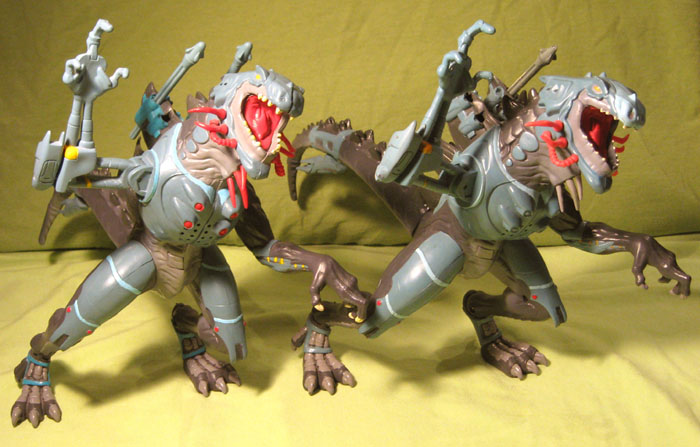 Two plastic Cyber-Godzilla prototype figures, showing slight variations in mold and painting. Photo by Jonathan Shyman. © 1998 Toho Co., Ltd.
Two plastic Cyber-Godzilla prototype figures, showing slight variations in mold and painting. Photo by Jonathan Shyman. © 1998 Toho Co., Ltd. Animation model sheets of Cyber-Godzilla. Photo courtesy of Sony Pictures Family Entertainment. © 1998 Toho Co., Ltd./Adelaide Productions, Inc.
Animation model sheets of Cyber-Godzilla. Photo courtesy of Sony Pictures Family Entertainment. © 1998 Toho Co., Ltd./Adelaide Productions, Inc.GODZILLA: THE SERIES Monster Figures
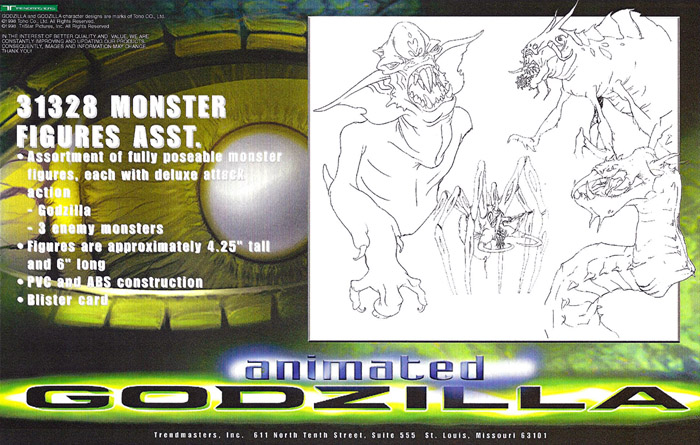 Trendmasters product announcement for their GODZILLA: THE SERIES monster figures. This promo was done early in the series` development, before the show had a name or the monster designs had been finalized. Photo courtesy of Jonathan Shyman. © 1998 Toho Co., Ltd.
Trendmasters product announcement for their GODZILLA: THE SERIES monster figures. This promo was done early in the series` development, before the show had a name or the monster designs had been finalized. Photo courtesy of Jonathan Shyman. © 1998 Toho Co., Ltd.Also planned for the GODZILLA: THE SERIES range were smaller poseable figures of Godzilla and other monsters from the show. The monster toys would be issued in two different scales. The "Large Godzilla Figure Assortment" would average around 5" tall and 7.5" long and come with a firing breath weapon. The smaller "Monster Figure Assortment" figures would be approximately 4.25" tall and 6" long, each with a "deluxe attack action" feature. The larger figures would have been packaged in a window box, the smaller sold attached to blister cards. GODZILLA (aka THUNDER SONIC GODZILLA)
The larger Godzilla figure for this series stands approximately 6" in height, with the smaller about an inch shorter. Playable features for the toy include the "Tornado Breath Missile", the "Thunder Roar" sound effect, and the spring loaded "Slashing Claw Attack".
Jonathan writes, "Once again, need I comment on the pose? Just look at it... it`s fabulous! I say that because it just looks so unconventional for a monster figure, and Godzilla to be posed like this... hunched over and with the arms in opposite positions. Beautifully balanced and menacingly graceful at the same time." "The catalog pic is resin and my prototype is a fully functional plastic one. It has a fin-activated roar on the left side, and it`s mouth opens at the same time when triggered by the fin. This is supposed to fire a missile out of Godzilla`s mouth, but I do not have that piece. The 5" and 6" Thunder Sonic final prototypes also have a slashing claw effect with the left arm. It snaps down by itself. I`m not sure, but I think it was also supposed to work in conjunction with the figure`s mouth opening and closing. Sometimes the arms don`t cooperate as they should, but that`s a prototype for you... a work in progress, and that`s fine with me." "Once again, I actually prefer the resin figure over mine, simply because it has a more raw and exact TV likeness to it. Don`t get me wrong, I love all these plastic prototypes, but the resin figure always look slightly better. I don`t think there was the standard dozen of these made as final figures... I may be wrong, but I`m only aware of 6 or 8 prototypes in existence."
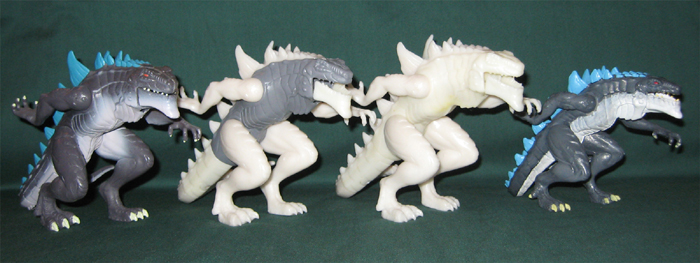 Four plastic Godzilla Thunder Sonic prototype figures, including two unpainted Godzillas and a painted figure in the smaller
Four plastic Godzilla Thunder Sonic prototype figures, including two unpainted Godzillas and a painted figure in the smaller 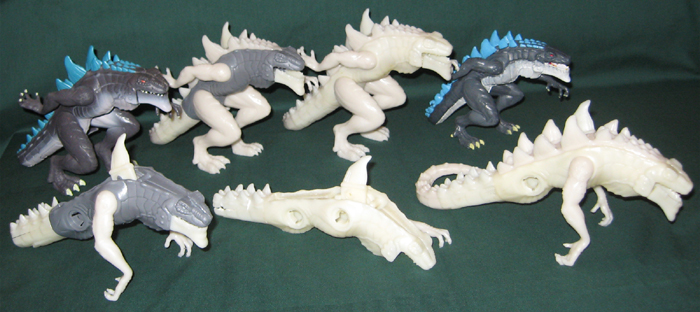 A selection of Godzilla prototypes, including three unfinished figures. Photo by Jonathan Shyman. © 1998 Toho Co., Ltd.
A selection of Godzilla prototypes, including three unfinished figures. Photo by Jonathan Shyman. © 1998 Toho Co., Ltd.C-REX
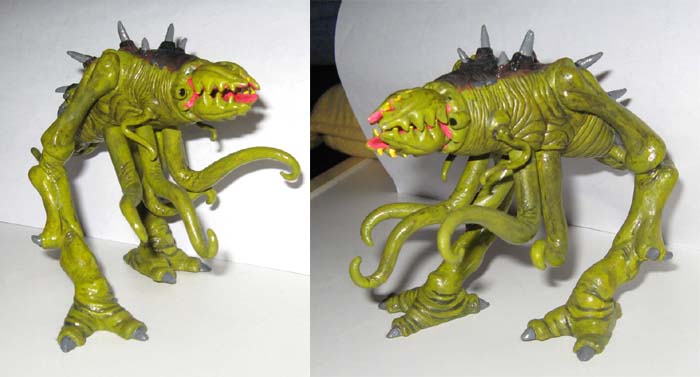 Two views of the Trendmasters prototype figure of C-Rex, Godzilla`s first monstrous foe in the animated series. © 1998 Toho Co., Ltd.
Two views of the Trendmasters prototype figure of C-Rex, Godzilla`s first monstrous foe in the animated series. © 1998 Toho Co., Ltd.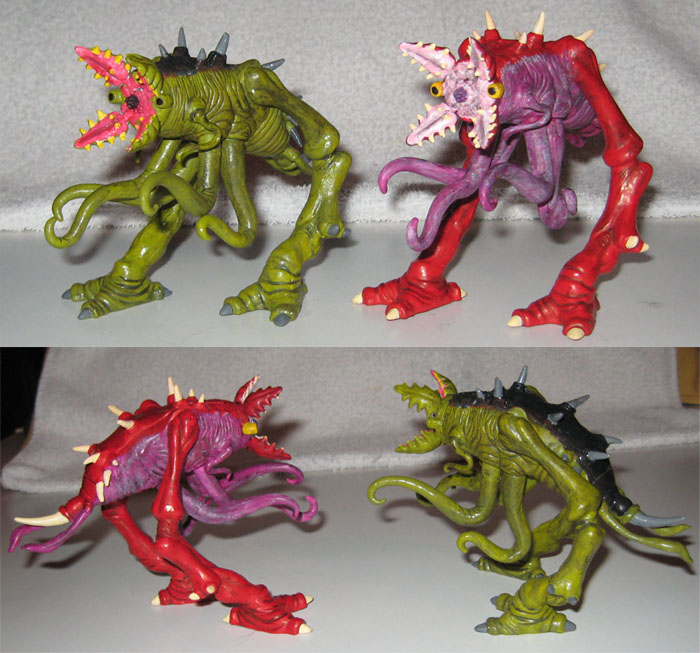 Front and back views of green and red variants of C-Rex with its beak open. Photos by Jonathan Shyman. © 1998 Toho Co., Ltd.
Front and back views of green and red variants of C-Rex with its beak open. Photos by Jonathan Shyman. © 1998 Toho Co., Ltd.Crustaceous Rex (C-Rex for short) was the first giant monster Godzilla fought in the animated series. A mutated sea creature living in the waters off Jamaica, C-Rex came ashore when its food supply (a school of man-eating squids) was wiped out by Godzilla. The monster was introduced in GODZILLA: THE SERIES Episode 102- NEW FAMILY- Part 2, returned for the three part MONSTER WAR story arc (Eps 115-117), and was later seen in Episode 135- S.C.A.L.E. as one of the inmates of the government containment facility called Monster Island. Trendmasters` C-Rex figure stood approximately 4" in height and around 5" long with the tentacles extended. The prototypes were hand painted and show better detailing than would usually be seen with mass produced, factory paint-jobs. There are at least two major color variants of the C-Rex prototypes. Trendmasters` product catalog depicts a resin C-Rex painted green, while a red-colored version was displayed at the company`s booth during Toy Fair 1999. Jonathan notes that, "There definitely seemed to be the most prototypes made of this particular G:TS figure because I do recall seeing an abundant supply of them, although they were all the unpainted cream colored plastic." "The main problem with these figures is the legs might have needed to be fixed a bit had they been released. They are a bit tough to pose because this creature does have such bizarre legs. With a lot of these prototype the legs were almost crossed or touching. Balancing these figures is quite a challenge, I think. But then again, as `a work in progress`, I`m still overjoyed to have them with whatever legs they came with."
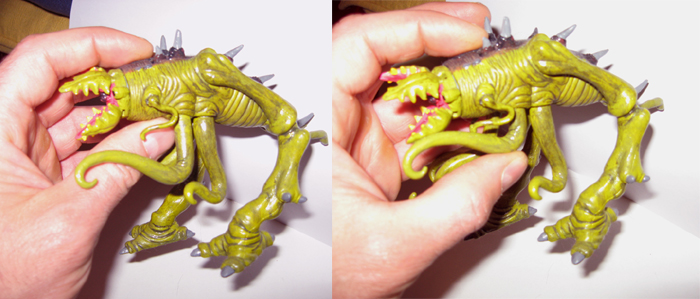 The growing tentacles extended (left) or pushed in (right). Photos by Jonathan Shyman. © 1998 Toho Co., Ltd.
The growing tentacles extended (left) or pushed in (right). Photos by Jonathan Shyman. © 1998 Toho Co., Ltd.The playable features on the toy included the "Power Chomp Beak" (the mouth could open and close like the petals of a flower), "Thrashing Limbs", and "Growing Tentacles". Jonathan explained, "There is a little lever above C-Rex`s head that, when slid forward or backward, would open and close the beak. Simple enough." "On the catalog pic, it says `Thrashing Limbs and Growing Tentacles`. Nice catchphrases to sell the figure, but I wouldn`t really say the limbs are too thrashing. There are two tentacles that can be pushed into the figure`s body a little bit, giving the appearance that, when pulled out, they appear to `grow` close to 3/4 of an inch. All four tentacles on C-Rex`s belly can swivel left and right until they hit the other tentacles blocking their way."
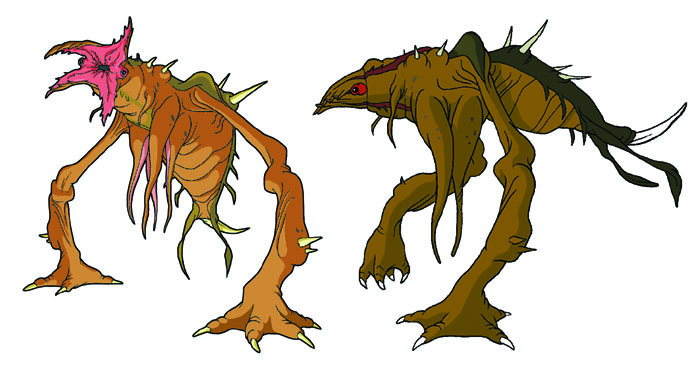 Animation model sheets showing C-Rex from the front with mouth open and from the side with mouth closed. Photo courtesy of Sony Pictures Family Entertainment. © 1998 Toho Co., Ltd./Adelaide Productions, Inc.
Animation model sheets showing C-Rex from the front with mouth open and from the side with mouth closed. Photo courtesy of Sony Pictures Family Entertainment. © 1998 Toho Co., Ltd./Adelaide Productions, Inc.QUETZALCOATL
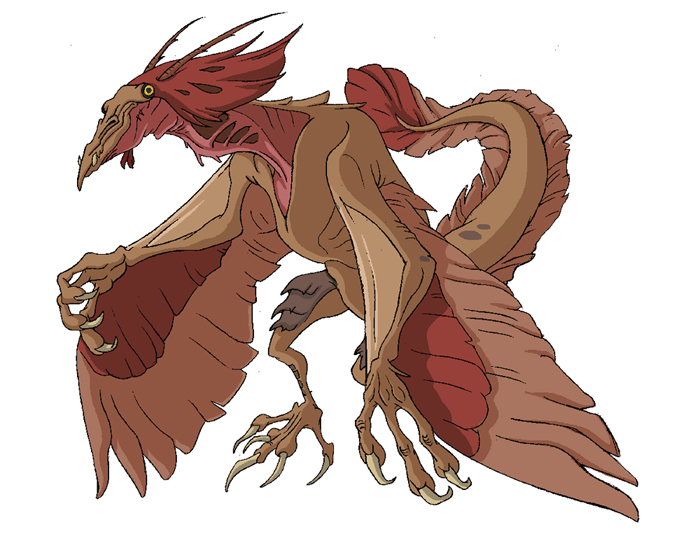 Animation model sheet for Quetzalcoatl. Photo courtesy of Sony Pictures Family Entertainment. © 1998 Toho Co., Ltd./Adelaide Productions, Inc.
Animation model sheet for Quetzalcoatl. Photo courtesy of Sony Pictures Family Entertainment. © 1998 Toho Co., Ltd./Adelaide Productions, Inc.The giant flying reptile Quetzalcoatl from GODZILLA: THE SERIES Episode 110- BIRD OF PARADISE was named after the feathered serpent deity worshiped by Mesoamerican civilizations such as the Mayans and the Aztecs. In the G:TS episode, the monster emerges from a dormant volcano and carries people back to its nest as food for its young. Trendmasters announced Quetzalcoatl as one of the first action figures in their GODZILLA: THE SERIES toy line. The character was featured (it`s name misspelled in various ways) in early advertising materials and press releases provided to publications such as the toy collectors` magazine Action Figure Digest, but was missing from later promotional publications, including the 1999 Trendmasters Product Review Guide. This has led to some speculation that the Quetzalcoatl figure was bumped from the G:TS lineup and replaced by the Yeti figure, which was not included in the initial G:TS press materials but does turn up in promo materials for the toys from 1999. But according to designer Bill Bronson, both Quetzalcoatl and the Yeti would have been included in Trendmasters` GODZILLA: THE SERIES range if the line had been picked up and gone into production. Quetzalcoatl has proven to be one of the rarest of the GODZILLA: THE SERIES prototypes. The Trendmasters promotional materials provide few details about the figure, other than it was apparently sculpted in the smaller "Monster Figure Assortment" scale to match monsters like C-Rex and the Yeti. Exactly what "deluxe attack action" feature was planned for the figure has not been revealed.
No plastic figures of Quetzalcoatl have surfaced in the years since Trendmasters went out of business, and it is possible that development of the figure was halted before it got to that stage. Only four prototypes were made in resin, and two of those are now owned by a private collector. After much detective work, Jonathan Shyman reports that, "Nobody knows what happened to the other two prototypes, if they even survived. They may have simply been destroyed in house at Trendmasters... nobody knows for sure." Two extremely different color variations are known to exist for the Quetzalcoatl figure. At Toy Fair 1999, the Trendmasters booth`s GODZILLA: THE SERIES display included a bright orange and yellow prototype that looked just like the character artwork from the company`s earlier promotional materials. The company also produced a more accurate resin paint master sample prototype that closely matched Quetzalcoatl`s brown and tan color scheme as seen in the animated series.
YETI (aka ROBO-YETI)
 Comparisons of Yeti plastic prototype and the resin sculpts as depicted in Trendmasters` catalog. Photos by Jonathan Shyman. © 1998 Toho Co., Ltd.
Comparisons of Yeti plastic prototype and the resin sculpts as depicted in Trendmasters` catalog. Photos by Jonathan Shyman. © 1998 Toho Co., Ltd.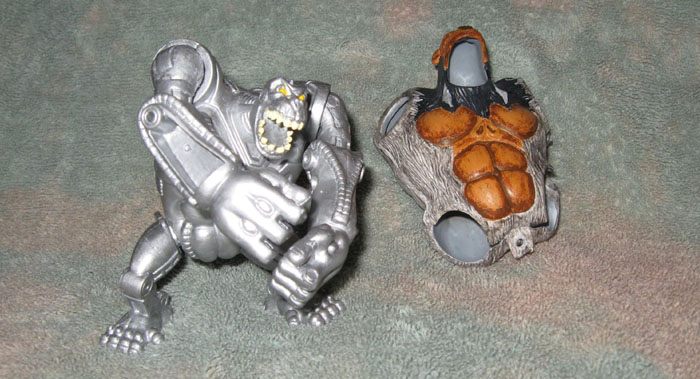 The figure with the outer skin removed to reveal the character`s robotic endoskeleton. Photo by Jonathan Shyman. © 1998 Toho Co., Ltd.
The figure with the outer skin removed to reveal the character`s robotic endoskeleton. Photo by Jonathan Shyman. © 1998 Toho Co., Ltd.The next monster chosen for the toy line was the Giant Albino Yeti that appeared in GODZILLA: THE SERIES Episode 113- COMPETITION. During a battle with Godzilla, the Albino Yeti`s skin was burned away to reveal a mechanical endoskeleton. What was expected to be another animal mutation was actually a machine called the Robo-Yeti, created for the Robotto Goeihei (Robot Protector) Program of the Japanese Self Defense Force.
COMPETITION was set in Japan, which gave the animation team the opportunity to make several references and in-jokes to Toho`s monster movies. The fight between Godzilla and the Giant Albino Yeti was inspired by KING KONG VS GODZILLA (Kingu Kongu tai Gojira, 1962), the Robo-Yeti was a nod to Mechani-Kong from KING KONG ESCAPES (Kingu Kongu no Gyakushu, 1967), and the robot`s creator Dr. Ifukube was named after Akira Ifukube, the original soundtrack composer of the Godzilla movies. Trendmasters` figure (identified in promotional materials simply as `Yeti`) stands approximately 4.5" in height, slightly hunched over with a bend at the knees. Playable features included a three-piece, removable soft plastic shell— representing the monster`s skin and fur— that would cover the Yeti`s arms and body (the metallic legs would apparently remain exposed), and "Grappling Harpoon Arms". Jonathan Shyman wrote, "The official Trendmasters catalog photo of the Yeti is, of course, two different prototypes. That is due to the fact that, as a resin piece, the outer skin of the Yeti is actually attached to the figure and cannot be removed. And the photo of the Robo-Yeti would be a separate figure depicting how it looks without the skin."
"You`ll notice that two of my plastic prototypes are missing the arm attachments of the outer skin. The skin came in three parts; a torso piece and two arms. It`s a plastic shell but has a rubbery feel to it, and it opens up from the crotch like a `grip`. Under the crotch area is a little overhanging piece hat has a hole in it, and that fits over top the adjoining piece that has a little nub on it, and it sort of snaps together. I say `sort of`, because it doesn`t hold all that well." "In the Trendmasters catalog pics it was common not to include most of the secondary accessories. In this case, they did not show the Yeti`s harpoon arms. The harpoons can attach to each of the Yeti`s forearms, and the tips are very similar to a clothespin." "None of these smaller prototype pieces have any electronic parts to them. The Yeti figures are hand painted, as most prototypes are. One of them has some cool looking brown and cream colored fur and a face painted to appear like armor. I heard from an ex-employee that Trendmasters did a thousand and one re-paints and initial paint apps on every toy line ever produced, so this is a perfect example." "The other amazing thing about this particular figure is, when the skin is removed, it has a more fierce look to it. The silver has more of a dirty wash over it, and it has red eyes, not yellow like my other two prototypes."
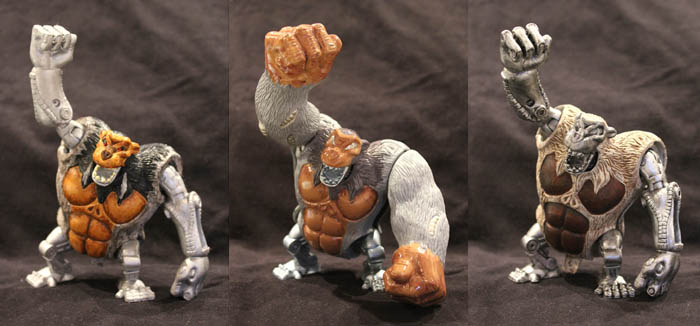 The three prototypes show some of the color variations considered for the figure. Photo by Jonathan Shyman. © 1998 Toho Co., Ltd.
The three prototypes show some of the color variations considered for the figure. Photo by Jonathan Shyman. © 1998 Toho Co., Ltd.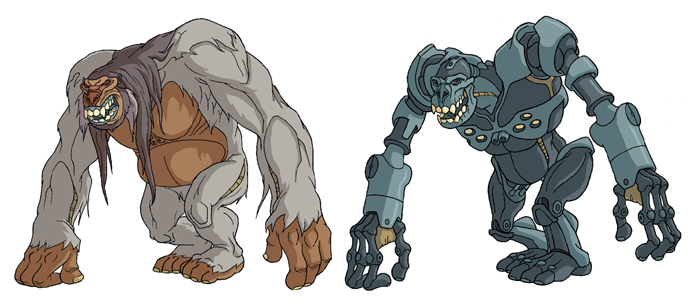 Animation model sheets of the Giant Albino Yeti and the Robo-Yeti. Photo courtesy of Sony Pictures Family Entertainment. © 1998 Toho Co., Ltd./Adelaide Productions, Inc.
Animation model sheets of the Giant Albino Yeti and the Robo-Yeti. Photo courtesy of Sony Pictures Family Entertainment. © 1998 Toho Co., Ltd./Adelaide Productions, Inc.Action Figure Assortment
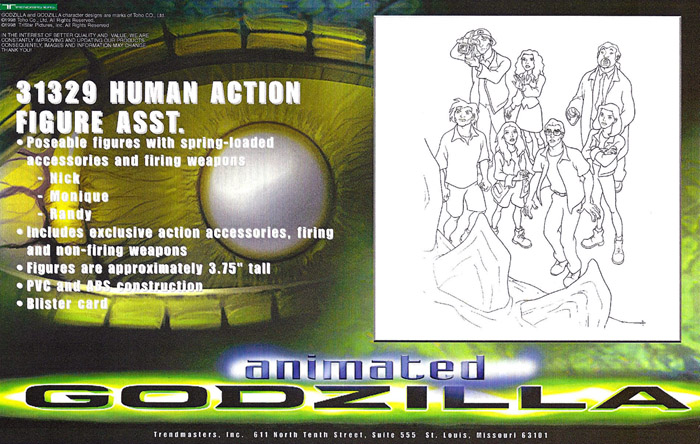 Action figure product announcement that was released before look of Sony`s Godzilla had been revealed. The illustration also depicts unused character designs for Audrey, Elsie, Nick, and Monique. Photo courtesy of Jonathan Shyman. © 1998 Toho Co., Ltd.
Action figure product announcement that was released before look of Sony`s Godzilla had been revealed. The illustration also depicts unused character designs for Audrey, Elsie, Nick, and Monique. Photo courtesy of Jonathan Shyman. © 1998 Toho Co., Ltd.The GODZILLA: THE SERIES toy line would also have included members of H.E.A.T. (Humanitarian Environmental Analysis Team), the main characters of the animated show. The initial product announcements listed poseable action figures of Nick, Randy, and Monique, but the latter figure was either canceled or pushed back for the expected next production wave since Monique is not mentioned again in Trendmasters promotional materials for G:TS. The human character figures averaged around 3.75" in height and would have come with spring-loaded accessories and/or firing and non-firing weapons. The toys would have been sold attached to blister cards. Trendmasters also planned a line of "Human Action Figures with Accessories" which would include a H.E.A.T. character figure plus an 8" long deluxe vehicle or weapon and other exclusive battle accessories. The toys for this series would have been packaged in a closed box with an acetate window to display the figure.
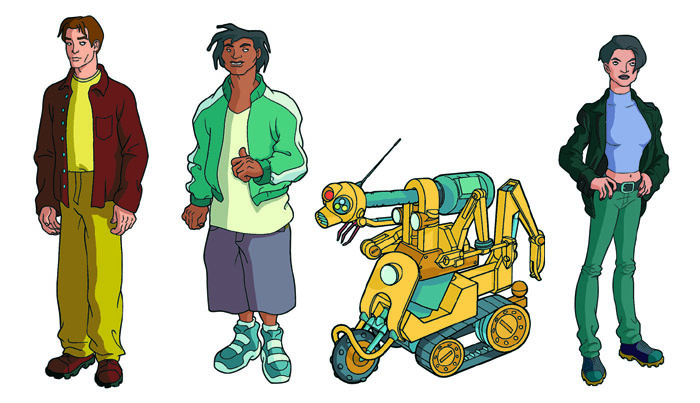 Animation model sheets of Nick, Randy, N.I.G.E.L. and Monique. Photo courtesy of Sony Pictures Family Entertainment. © 1998 Toho Co., Ltd./Adelaide Productions, Inc.
Animation model sheets of Nick, Randy, N.I.G.E.L. and Monique. Photo courtesy of Sony Pictures Family Entertainment. © 1998 Toho Co., Ltd./Adelaide Productions, Inc.NICK
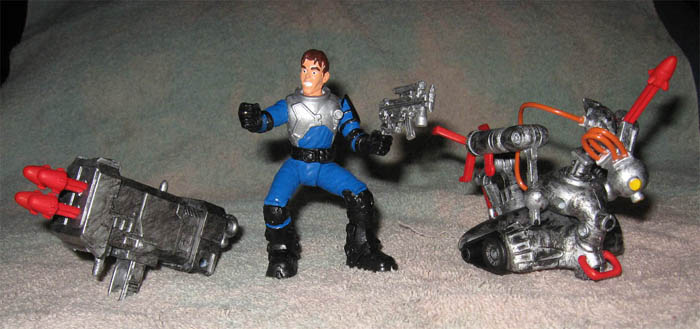 Plastic prototype of the Nick figure with accessories. Photo by Jonathan Shyman. © 1998 Toho Co., Ltd.
Plastic prototype of the Nick figure with accessories. Photo by Jonathan Shyman. © 1998 Toho Co., Ltd.Nick Tatopoulos was the lead character in the 1998 GODZILLA movie and GODZILLA: THE SERIES. A research biologist recruited by the American military to assist in their efforts to stop the monster, Nick was played in the film by actor Matthew Broderick as an "absent-minded professor" type. The character was revamped for the animated series to become more of a pro-active scientist (voiced by Ian Ziering) with a strong sense of responsibility. Imprinted as a parent figure by the newborn Godzilla, Nick is torn by his fear of its destructive capabilities and the knowledge that the reptile is not inherently evil. He forms H.E.A.T. to study the creature and protect mankind from other mutations popping up all over the globe. Godzilla’s continued assistance in defeating new monsters solidifies Nick’s resolve to protect the beast. Keeping in mind that the primary demographic for the GODZILLA: THE SERIES toy line was boys ages 2-11, Trendmasters` Nick action figure presents a much more aggressive and dynamic take (dressed in a stylized uniform rather than Nick`s traditional street clothes) than was seen in the television show. The figure came with two weapons; the large spring-loaded "Quad-Firing Missile Blaster" and a smaller Uzi machine gun. Having acquired three Nick plastic prototypes, Jonathan Shyman noted that the figures, "are roughly 3.75" in height and came with huge firing guns that are almost too big for the figures. These massive guns snap onto the right arm of each figure and have to be positioned just right or their weight will make the toy topple over. Two of my Nick prototypes are unpainted; the other is hand painted. Each arm, and leg, and head is articulated." Early on, Trendmasters announced plans for a "Human Action Figures with Accessories" release that would have packaged Nick with a Jet Pack. Months later, Action Figure Digest ran photos of the GODZILLA: THE SERIES toys that paired Nick with a chrome-colored variant figure of the robot N.I.G.E.L.
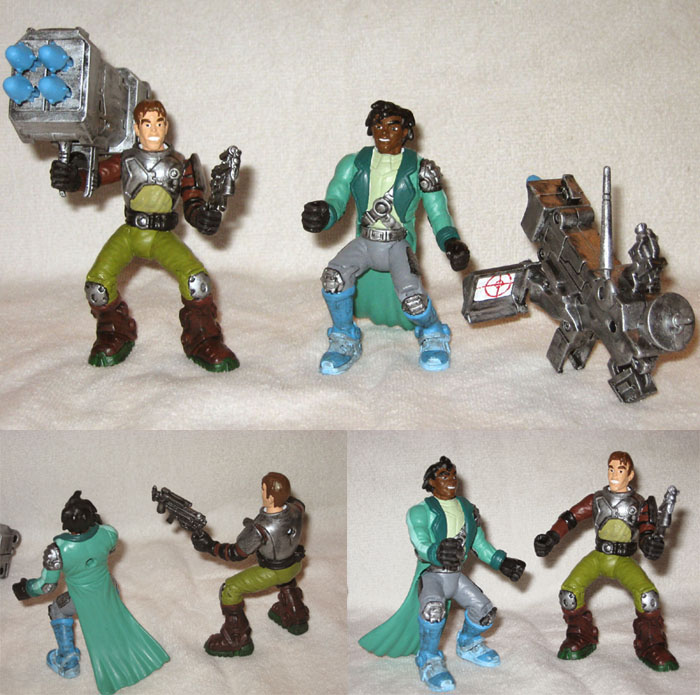 Master prototype Nick and Randy figures. Note that the uniform colors on these toys match the characters` primary outfits in the animated series, right down to the striping on Randy`s sleeves. Photos by Jonathan Shyman. © 1998 Toho Co., Ltd.
Master prototype Nick and Randy figures. Note that the uniform colors on these toys match the characters` primary outfits in the animated series, right down to the striping on Randy`s sleeves. Photos by Jonathan Shyman. © 1998 Toho Co., Ltd.RANDY
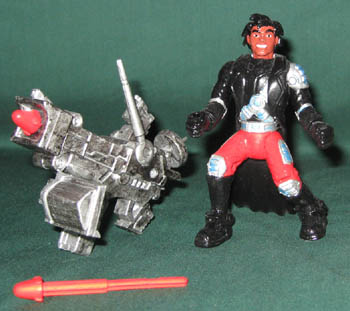 Plastic prototype of the Randy figure with accessories. Photo by Jonathan Shyman. © 1998 Toho Co., Ltd.
Plastic prototype of the Randy figure with accessories. Photo by Jonathan Shyman. © 1998 Toho Co., Ltd.Randy Hernandez was a character created for the animated series, played by Rino Romano (the voice of Spider-Man in SPIDER-MAN UNLIMITED, and Batman in THE BATMAN). The youngest member of H.E.A.T., Randy is an extremely skilled computer hacker, brimming with attitude and quick with a wisecrack, particularly at inappropriate moments. A totally impulsive adrenalin junkie, he tends to leap before looking and looks when he should be running. Randy is totally, madly, completely infatuated with Monique. He sees her daredevil acts (always done in the line of duty) as a call to action: he will follow her anywhere to show he’s every inch the man that she is. Lamentably, he is not, as she frequently has to rescue him from danger. Trendmasters` Randy action figure has the same specs (height, articulation, etc) as their Nick figure. In GODZILLA: THE SERIES, the character generally wore "slacker-style" clothing, but the figure is dressed in a uniform with a long black trenchcoat. Randy`s accessory was the oversized "Cyber-Tracker Rocket Launcher", a spring loaded gun that fired plastic missiles. The gun would snap onto the right arm of the figure and— as was the case with Nick`s accessories— would often cause the toy to tip over. Early Trendmasters promotional materials also advertised a boxed "Human Action Figures with Accessories" Randy that would have packaged the figure with an 8" long Combat Cycle. Jonathan owns four plastic prototypes of Randy; one hand painted figure and three unpainted pieces. He wrote, "Something that I think is very interesting to note with my three unpainted Randy figures.. they are all slightly different with the color plastic used. I do believe these are all "first shots" prototypes, meaning that they were made up with whatever plastic was available at the factory at that time. Thus we have one of the Randy`s with orange legs and cream colored torso, one with a black cape and cream body, and another with the all cream colored body plastic."
N.I.G.E.L.
The final member of H.E.A.T. planned for the initial wave of GODZILLA: THE SERIES toys was the robot N.I.G.E.L. Built by the hypochondriac scientist Mendel Craven, N.I.G.E.L. is a research robot whose name is an anagram for “Next-millennium Intelligence Gathering Electronic Liaison”. Low-tech looking, but high-tech acting, his main function is to go where the human crew of H.E.A.T. cannot; the ocean floor, inside an active volcano or near highly toxic fumes… which usually results in the robot getting pummeled, bashed-up or obliterated (in an ongoing homage to Kenny from SOUTH PARK). N.I.G.E.L. also serves as a vehicle for the ongoing rivalry between Craven and Randy. Craven programmed the yellow robot with the selfless heroic personality he imagines himself to possess, so Randy is constantly reprogramming N.I.G.E.L’s personality just to drive Craven crazy. Therefore, N.I.G.E.L. will often speak in a variety of funny voices, imitating celebrities like Elvis Presley or John Wayne. All of N.I.G.E.L.`s voices were provided by actor Tom Kenny, who would go on to play the title character in the smash hit SPONGEBOB SQUAREPANTS. Outside of Nick, N.I.G.E.L. is the one member of H.E.A.T. who can get physically close to Godzilla, who regards the little robot as something like a beloved chew toy.
Trendmasters` N.I.G.E.L. was the first GODZILLA: THE SERIES action figure to not closely resemble its animated series counterpart. Small and (intentionally) clunky-looking in the show, the robot was redesigned and sculpted at a larger scale in comparison to the figures of Nick and Randy. The prototype N.I.G.E.L. is roughly 7" long and 3.5" high and comes with a robotic claw, a firing rocket launcher, and a spring-action arm. The magazine Action Figure Digest ran a photo of a chrome-colored variant figure of N.I.G.E.L., showing the robot included with Nick in Trendmasters` "Human Action Figures with Accessories" range for GODZILLA: THE SERIES. The chrome version is not listed in later Trendmasters` product catalogs. Jonathan Shyman noted, "If you didn`t have the Action Figure magazine then you would never know this chrome version N.I.G.E.L. was ever planned." Hand painted plastic prototypes exist for both color versions. "Of the entire line of G:TS figures," Jonathan wrote, "I would say that N.I.G.E.L. is probably the least interesting. Cool figure, don`t get me wrong, but I`m not sure if it actually looks as much like the TV cartoon as it should. And the figure basically doesn`t do anything special, apart from fire a missile, and even that on the yellow one is not so smooth running. The firing rocket launcher works better on my chrome version, but the robotic claw on both is kind of pointless. I was kind of hoping that claw might open and close more like a robot hand, but it doesn`t move much on either one of my figures, even with the little red lever sticking out from the claw arm."
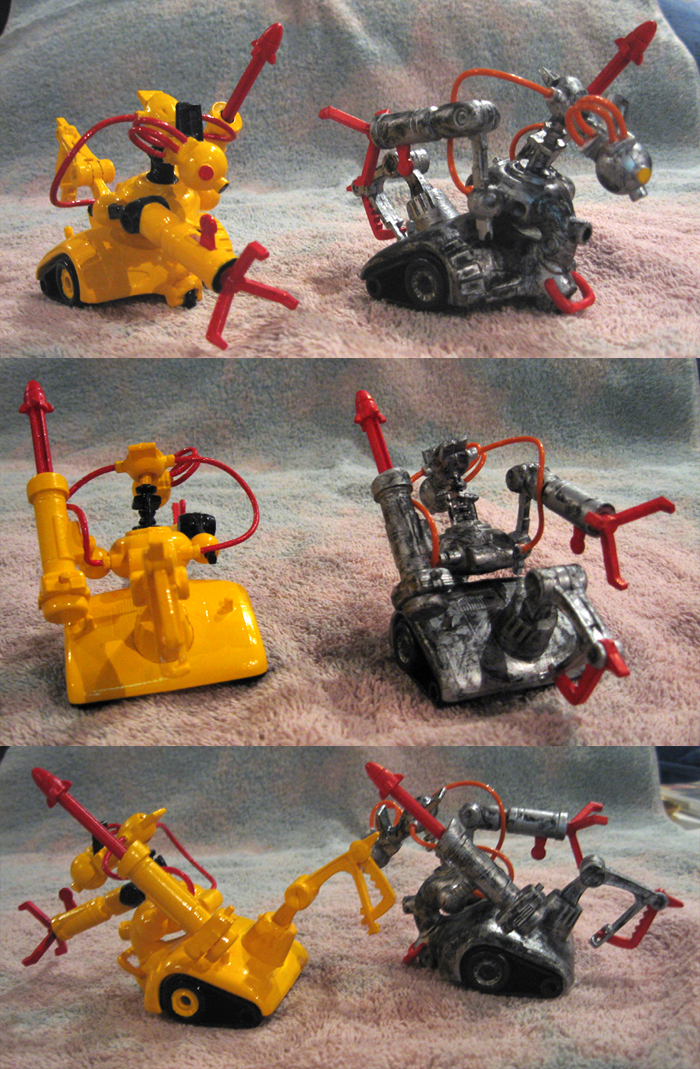 Front, back, and side views of the N.I.G.E.L. prototypes. Photos by Jonathan Shyman. © 1998 Toho Co., Ltd.
Front, back, and side views of the N.I.G.E.L. prototypes. Photos by Jonathan Shyman. © 1998 Toho Co., Ltd.Vehicle Assortment
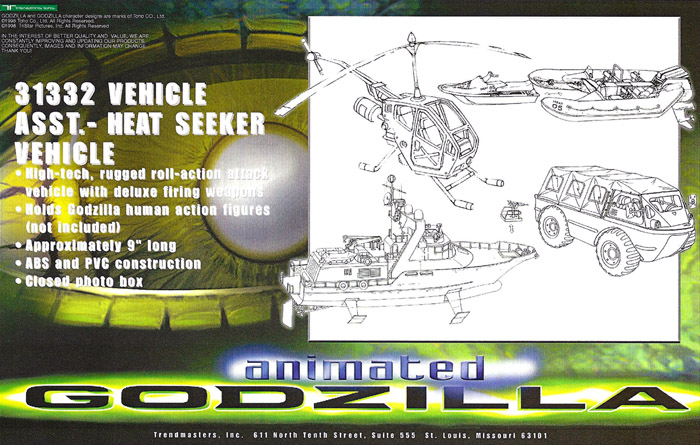 Early product announcement for vehicles from GODZILLA: THE SERIES. Photo courtesy of Jonathan Shyman. © 1998 Toho Co., Ltd.
Early product announcement for vehicles from GODZILLA: THE SERIES. Photo courtesy of Jonathan Shyman. © 1998 Toho Co., Ltd.Beyond the characters and monsters, Trendmasters` GODZILLA: THE SERIES line would have included a range of toy vehicles. The earliest announcements from Trendmasters describe plans for quite an extensive line of "rugged attack vehicles with deluxe firing weapons" that would average 9" in length and be scaled to hold the G:TS human action figures. The toys would have been packaged in a closed box with exterior photos and art.
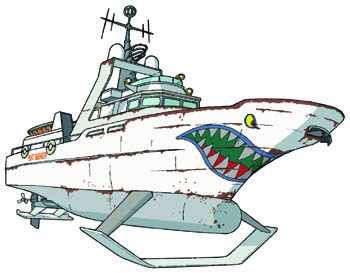 Animation artwork of the Heatseeker. Photo courtesy of Sony Pictures Family Entertainment. © 1998 Toho Co., Ltd./Adelaide Productions, Inc.
Animation artwork of the Heatseeker. Photo courtesy of Sony Pictures Family Entertainment. © 1998 Toho Co., Ltd./Adelaide Productions, Inc.Among the vehicles depicted in the advanced artwork were a roll-action 4 wheel drive rugged terrain jeep, a one man helicopter, and a speedboat that would also shoot out a smaller sized jet ski. The centerpiece of the line would have been the Heat-Seeker, the boat used by H.E.A.T. as a mobile headquarters in their adventures with Godzilla around the world. But by the time the first GODZILLA: THE SERIES prototypes were revealed, the vehicle lineup had dramatically changed. No new vehicles were produced; instead Trendmasters opted to reissue the helicopter and F/A-18 jet fighter toys which had previously been used for their INDEPENDENCE DAY and GODZILLA `98 lines (and would be used yet again for the company`s BATTLEFIELD EARTH range). Reusing the existing sculpt molds would save money, and the only difference with the vehicles would be in the color scheme and stickers showing the H.E.A.T. insignia. F/A-18 HORNET STRIKE JET Playability features would include firing grappling hooks, Sidewinder missiles, a harpoon, catapult landing gear, and breakaway battle damage. APACHE CAPTURE COPTER Playability features would include an exploding drop net, Hellfire missiles, grappling hooks, a pivoting machine gun, and breakaway battle damage.
What May Have Come Next
With the initial GODZILLA: THE SERIES lineup in place, Trendmasters` creative development team continued to work on new concepts and toy designs until the entire line was finally scrapped. The following images reveal some of the monsters from the animated show that were being developed as toy figures and may eventually have been released if the G:TS toy series had gone into production. GIANT WORM (aka EL GUSANO)
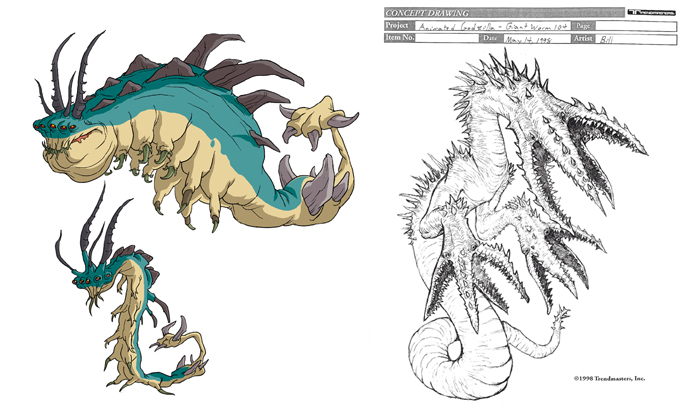 On the left: Animation character models for the giant worm El Gusano. Right: Bill Bronson`s concept sketch for the Trendmasters` Giant Worm figure. Photo courtesy of Bill Bronson and Jonathan Shyman. © 1998 Toho Co., Ltd./Adelaide Productions, Inc.
On the left: Animation character models for the giant worm El Gusano. Right: Bill Bronson`s concept sketch for the Trendmasters` Giant Worm figure. Photo courtesy of Bill Bronson and Jonathan Shyman. © 1998 Toho Co., Ltd./Adelaide Productions, Inc.El Gusano (meaning "the worm") was a giant, mutated worm that first appeared in GODZILLA: THE SERIES Episode 104- D.O.A. and later returned for the MONSTER WAR story arc. Bill Bronson`s concept sketch for the toy figure shows a radically different design than was seen in the animated series. CYBER-FLY
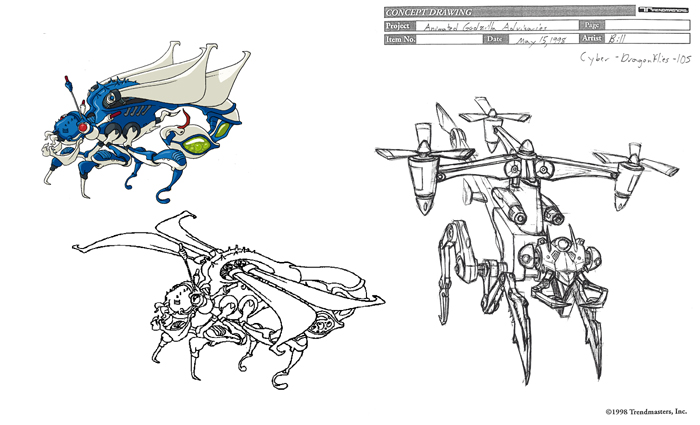 Left: Animation character models for the Cyber-Fly with wings retracted and extended. Right: Bill Bronson`s concept sketch for the Cyber-Fly toy figure. Photo courtesy of Bill Bronson and Jonathan Shyman. © 1998 Toho Co., Ltd./Adelaide Productions, Inc.
Left: Animation character models for the Cyber-Fly with wings retracted and extended. Right: Bill Bronson`s concept sketch for the Cyber-Fly toy figure. Photo courtesy of Bill Bronson and Jonathan Shyman. © 1998 Toho Co., Ltd./Adelaide Productions, Inc.Appearing in GODZILLA: THE SERIES Episode 105- THE WINTER OF DISCONTENT, the Cyber-Flies were cybernetic flying attack drones developed by Solstice Industries under contract to the Pentagon. The robots` creator Cameron Winter decides to field test the Cyber-Flies against Godzilla, who quickly destroys them. MUTANT SEWER RAT
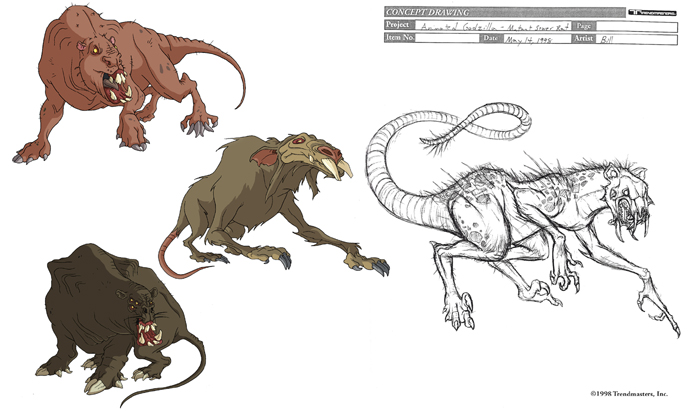 Left: Model sheets showing some of giant Mutant Sewer Rats from GODZILLA: THE SERIES. Right: Bill Bronson`s take for the Trendmasters` G:TS line. Photo courtesy of Bill Bronson and Jonathan Shyman. © 1998 Toho Co., Ltd./Adelaide Productions, Inc.
Left: Model sheets showing some of giant Mutant Sewer Rats from GODZILLA: THE SERIES. Right: Bill Bronson`s take for the Trendmasters` G:TS line. Photo courtesy of Bill Bronson and Jonathan Shyman. © 1998 Toho Co., Ltd./Adelaide Productions, Inc.Several Mutant Sewer Rats were introduced in GODZILLA: THE SERIES Episode 106- CAT AND MOUSE, and one would return for MONSTER WAR. The rats came in a variety of shapes and sizes and, while Bill Bronson`s toy concept was a fresh design, it was in keeping with the creatures seen in the animated show.
For more information on GODZILLA: THE SERIES please see the earlier coverage here on SciFi Japan:
- DVD Reviews: GODZILLA: MONSTER EDITION and GODZILLA: THE SERIES
- The Ultimate Guide to GODZILLA: THE SERIES
- GODZILLA: THE SERIES on Netflix Streaming</li


